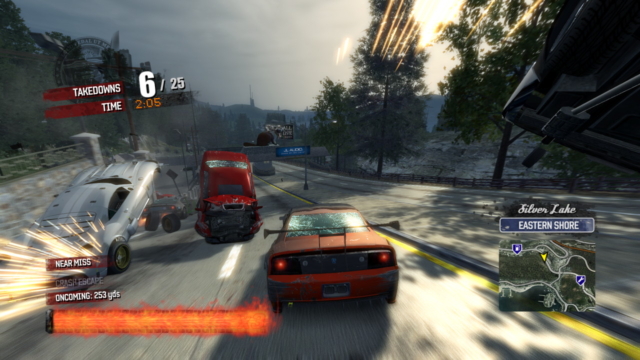
Burnout Paradise: The Ultimate Box
Written by: Rik
Date posted: December 31, 2021
- Genre: Racing
- Developed by: Criterion Games
- Published by: Electronic Arts
- Year released: 2009
- Our score: 6
Burnout was an early PS2-era game based around two simple but relatively novel features: one, to go faster, you needed to earn a boost by driving dangerously; and two, crashing at high speed was no longer the two-cardboard-boxes-nudging-each-other cop-out favoured by many racers, and instead the real-life nightmare of smashed glass and twisted metal would be replicated more closely.
It was a nice twist on the standard lap-based fare of the time, with the two headline innovations providing a nice balance of risk and reward. As the series gained momentum during the mid-00s, a succession of sequels put increasing focus on battling other racers and forcing spectacular crashes and pile-ups.
Burnout was firmly a console-only franchise, however, until Paradise, the series’ debut on 360/PS3, belatedly made its way to PC in the form of The Ultimate Box, which added a few online modes as well as motorbikes to the original release. With this game, the action has been transposed to an open-world setting, and Paradise City is yours to explore, race and crash about in as you please.
When you eventually get to it, that is. A combination of an overly-long tutorial from the nominated in-game radio presenter and ‘rad dude’ DJ Atomika and a veritable nightmare of impenetrable menu systems has the effect of making Burnout Paradise seem much more complex than it actually is. All the while, Paradise City (yep!) by Guns N’ Roses will playing, as will be the case each and every time you launch the game, to the extent that not only will you get bored of the song, you kind of imagine the band doing so too, with each rendition seemingly getting slower and more listless each time you hear it, as if Guns have been locked inside your computer for eternity by their record company as punishment for the delayed release of Chinese Democracy.
There’s no beating around the bush: I found Paradise hard to get into, having made several abortive attempts to play it for review over the years. Despite being relatively au-fait with the alienatingly youth-oriented trimmings that accompany most arcade racers, none had ever made me feel quite so overwhelmed and out of touch as Paradise. I last resolved to give it another go as part of a mooted head-to-head with 2008’s instalment of Need for Speed, Undercover, and for all that game’s myriad faults, it somehow seemed much easier to digest and return to.
As it turns out, Paradise is still a fairly standard 00s arcade racer, with nothing massively complicated about it. It’s structured in a similar way to other open-world racing games of the era, in that you explore the map to uncover race events, which come in a variety of different flavours, and have a base of operations in which your various cars are stored.
However, such is the commitment to the open-world concept, you can’t at any stage shortcut to a particular race, event, or point on the map. Wherever you want to get to, you have to drive there from where you are. Races aren’t accessed from a menu but by driving to them and then hitting a combination of joypad triggers to start. And none of the events have a set route: while some have a target destination, how you get to that destination is up to you.
There are broadly three main race types: Race, which is point to point stuff, against one or a handful of other cars; Stunt Run, which involves throwing your car around, up, and off the top of bits of scenery in an attempt to meet the assigned score target; and Road Rage, which involves performing a set number of ‘takedowns’ of other racers by smashing them into traffic or walls within a set time limit.
There are also three different classes of car, each one of which most suits a particular event type: speed cars are best used in races and stunt cars in Stunt Runs, while durable aggression-class cars will work best in Road Rage events. You can, however, use whatever kind of car you like in each event. And, in time-honoured tradition, new and better cars are unlocked as you progress.
One other way to access bonus vehicles is to complete the Burning Route races, which are time-trial events unique to each car, and reward you with a custom, slightly-upgraded version, of that same car. Another supplementary event category is Marked Man, a survival mode in which you have to make it to a specified point in the city while avoiding the attentions of some extremely beefy respawning opponents, whose sole focus is to smash you to smithereens.
And that’s the meat of it, really. Complete a certain number of events, in any order, and your Burnout Paradise driving license, the barometer of overall progress, will eventually be upgraded. Each time it is, completed events will be reset, allowing you to try them again as part of the qualification for the next license. There are various levels of license, from the ‘well done, you can drive, dummy’ one to the ‘oh my god, you have impressively squeezed every last drop of content out of this thing’ ultimate achievement. Exactly where the actual ‘end’ of the game is for normal people isn’t entirely clear. But we’ll get onto that.
The ethos is: go anywhere and do anything, at any time. And it takes a bit of getting used to. The pattern of most arcade racing games involves a great deal of repetition (and rage-quitting) until a particular challenge is cleared. That’s not encouraged here, though I belatedly discovered it was actually possible to restart an event through a slightly convoluted mechanism (hold the emergency brake to come to a stop and quit a race, then hit ‘6’ on the numpad, and you’ll find the option) rather than driving all the way back across the map to the start line. Clearly, though, the intention is for you to just dust off your failure and move onto something else nearby.
Personally, I quite like the traditional structure of focusing relentlessly on a race until you beat it. Ideally, the challenges should burn briefly but brightly, holding your attention for a short, intense period, until they’re mastered and then forgotten about entirely. But I admit that there’s a certain sense of liberation in just shrugging your shoulders and finding another event to try, and of course, if you get stuck, it means you’re not tied to that frustrating race that you just can’t beat. Progress depends on completing some challenges, not all of them.
The driving itself is at the very arcade end of the spectrum. Although cars do look and handle differently, there are no concessions to real world racing like manual gearboxes, rev counters or speedometers. The main item on the HUD is your boost meter, which is filled up, as per series tradition, through dangerous driving.
All three types of car can earn boost by driving on the wrong side of the road, close encounters with traffic etc. But stunt cars earn it more quickly through stunts and stunt-adjacent tricks like drifting and handbrake turns, and aggression cars gain more boost by bashing other racers into the wall and smashing through scenery.
The boost on speed cars, meanwhile, is most closely aligned to the dangerous driving model, and Burnout of old, and can only be used once when completely filled (unlike the others, which can be activated as needed). But it also provides the biggest increase in terms of speed. In general, mastery of the drift is necessary to take corners while keeping your foot down, and there is considerable forgiveness when it comes to losing momentum from minor scrapes, to offset the otherwise uncompromising approach to collisions.
My experience can broadly be divided into two phases of play. In the first, I made reasonable progress across a few short sessions that had fairly long periods between them, during which I had intermittent fun without ever quite feeling that I had a handle on what I was going to do next, or that I was actually any good at the game. And then, after about 12 or so hours of play, I was somewhat surprised when the credits started rolling.
Having subsequently been presented with the further option of completing all 120 events in the city for an Elite license, after consulting various online guides (#fakegamerguy) I decided that while I probably could be considered to have completed the game, it was such an inconsequential and slightly anti-climactic event that it might be worth crashing on through to some of the completist-type stuff.
All of which implies that, while Burnout Paradise is certainly technically competent, and delivers on paper most of what you might theoretically want from a good example of this type, the experience falls short of what a great arcade racer should deliver. Although the action is good-looking, smooth and fast (sometimes incredibly fast) and generally well-realised, there’s something slightly clinical and unengaging about it too. The lack of need to be good at everything keeps you going but it also means you remain distant from the action to a certain extent. Those admittedly repetitive ‘I’ll beat you, you bastard’ racing moments are also the ones that forge a bond with the game.
The main thing that kept me interested was the various Burning Route races, which provide the opportunity for a focused time-trial with the tangible reward of a new vehicle. But unlike in, say, Test Drive Unlimited, the cars themselves aren’t officially licensed, or that interesting to drive, so there’s insufficient motivation to make you want to build up your collection.
In my second phase of play, when I decided to at least start the quest to complete all in-game events, it soon became apparent that I was ill-equipped for the task. The gentle, consequence free progression of the first phase was replaced by time-consuming failure, and the realisation that the previous 12 hours were largely a waste of time in terms of getting me ready for what followed.
In particular, the assumption that you have somehow assimilated the geography of Paradise City starts to grate. The freedom to pursue your own route is theoretically an honourable thing, but with no GPS (other than the game occasionally flicking your indicators on to tell you to take an upcoming turn after you veer wildly off course) it’s a tough balance to strike between driving as fast as possible and working out the best route.
With one eye on the mini-map, the result, more often than not, is multiple crashes and lost races. At which point, interventions from the recurrent voice of DJ Atomika, who until this point I had managed to mostly tune out, start to get a bit personal, and are all variations on him advising the listeners of his fake radio station that he’s getting reports in of a lame dude lacking the ‘tude to get rude on the roads in Paradise (City). Meanwhile, Road Rage events are elongated, requiring a ludicrous number of takedowns for completion, and extending a fun short bash-fest to a slightly tedious and repetitive crunch around the city.
Ditto the now-tougher Marked Man events, in which the lack of distinction between being ‘Taken Down’ and ‘Wrecked’, and also between the physical appearance of your car and your actual proximity to failure of the challenge on account of it being rendered unroadworthy, becomes increasingly obvious. It does feel quite anticlimactic to successfully make it to the end of this supposed survival event with progress having been repeatedly interrupted by what look like terminal interactions with a concrete wall, but as far as I can see, the only clue that you’re ever in real danger is when the game explicitly warns you that you’re one crash away from being toast and advises you to find a drive-through repair shop.
It’s perhaps unfair to place too much emphasis on this second phase, which I guess has to be considered as a supplement to the main career trajectory. But between the two, it sort of goes from a broadly enjoyable but slightly easy racer to a much harder, longer slog. There’s certainly plenty still to do, even outside a shot at the full 120 events: there are timed challenges to complete for each and every road as well as the opportunity to engage Showtime, a mildly farcical crash challenge which involves bouncing the twisted shell of your vehicle into traffic in the hope of causing massive amounts of damage. But for me, somehow, the desire to press on and explore new challenges was largely absent.
Ironically, the most significant source of additional enjoyment was the game’s motorbikes, engagement with which I had put off on the basis that bikes had been a later addition to the original version of Paradise on consoles, and were something that many racers of this era for some reason felt obliged to include without much success. Despite feeling fairly transparently tacked on as a feature, with boost, stunts and spectacular crashes all absent, this somehow works in the game’s favour, allowing you to engage in a series of timed challenges that allow you to race through the city at high speed, devoid of distractions.
Perhaps it’s a result of my almost total ignorance of Burnout since the 2001 original, but I found Criterion’s first contribution to the Need for Speed series, Hot Pursuit, in many ways more faithful to the spirit of what that first Burnout game was about: go fast, take risks, don’t crash. That all seems to be lost here, with the notion of driving as quickly as possible sitting uneasily in the content-saturated open-world setting and alongside the fetishisation of crashed cars and chaos: you even have to find and smash into a new car to unlock it, then take the wreck from your base (a junk yard) to get it repaired before you can drive it. It just seems slightly odd to me that Paradise is considered a series high point rather than a fun but slightly misguided product of the era.
Ultimately, I guess it all comes down to your personal enjoyment of the open world environment and the driving model. Although comparisons with the newer title NFS: Hot Pursuit might not be fair, I’d also have to nominate Test Drive Unlimited as preferable in terms of free-form driving and exploration, Flatout 2 for a better example of unhinged crash-bash hi-jinks and capers, and even 2005’s Need for Speed: Most Wanted for trying to avoid getting smashed into a wall by AI opponents within an open urban environment. (Speaking of Most Wanted, it also received a 2012 reboot courtesy of Criterion, which I haven’t yet played, and it’ll be interesting to see if it’s more like this or Hot Pursuit).
Despite the slightly negative tenor of this write-up, I’m certainly not suggesting that Paradise is a bad game, just one that left me slightly cold, particularly in the light of seemingly universal critical and fan acclaim, all of which seemed to be re-heated and re-iterated upon the release of the 2018 remaster. Clearly, I’m in the minority, but it just didn’t quite click for me. And as a by-product of playing it, I also now sort of hate Paradise City by Guns N’ Roses. Take! Me! Hoo-ome! (ARRRRGH!)

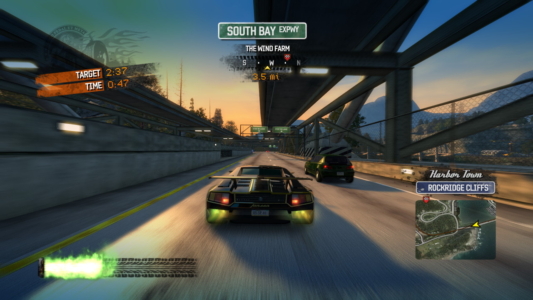
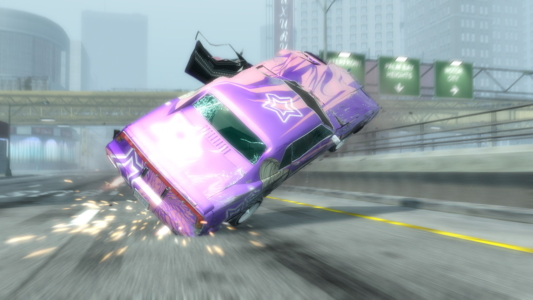
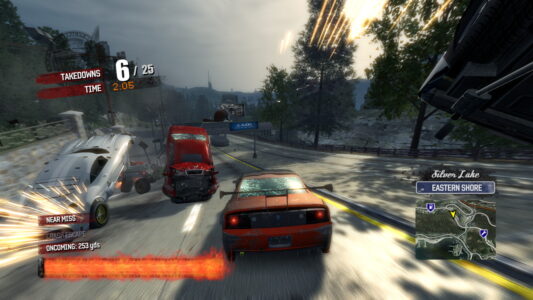
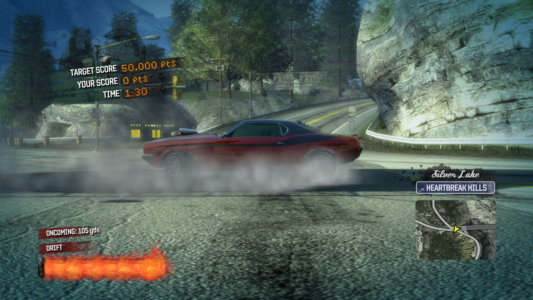
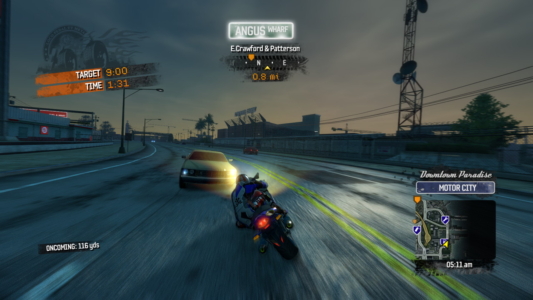
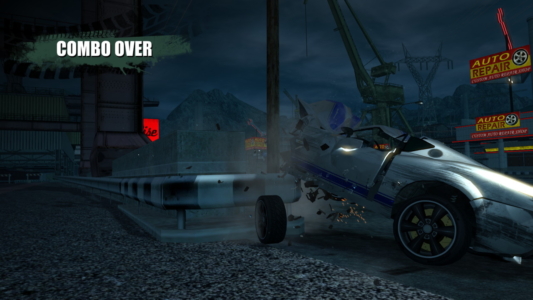

 Posts
Posts
Hi Rik,
Before Paradise, my first and only experience with Burnout was at the time of Takedown’s release.
There, only two or three events separated me from the credits, but I never managed to finish them, because the difficulty had risen to an unthinkable level. So, I completely abandoned that game.
Paradise was rewarded by the press, and some of my friends recommended it, but I, mindful of what I had been through with Takedown, was skeptical. Anyway, I bought the game and I think I managed to finish all the events at least once (although I wouldn’t swear it), but I felt consumed by that experience. The DVD is still on the shelf, but I don’t know if I’ll ever want to go back to it.
And, my word, I’ve never hated Guns N’ Roses my whole life, but they managed to piss me off in a way I never expected! What if the devs had replaced the Guns, for example, with the Nirvana, which I adored?
Good thing nothing like that happened.
April 26, 2022 @ 11:13 am
Hi Oleg,
I only ever really played the first Burnout on PS2, which I liked, but was completely rubbish at. I think for many Takedown is the high point on that era of hardware.
Currently giving the Criterion NFS Most Wanted remake some of my time – really not sure what I think so far, but seems like more Burnout Paradise than Hot Pursuit to me.
Planning to do a Soundtracks piece on this one too where I plan to delve further into why the use of GnR is so annoying here…
Hope you’re well!
April 26, 2022 @ 3:22 pm